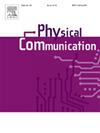Physical layer security performance of cooperative backscatter-NOMA communication systems for multi-tags and multi-eavesdroppers
IF 2
4区 计算机科学
Q3 ENGINEERING, ELECTRICAL & ELECTRONIC
引用次数: 0
Abstract
Ambient backscatter communication (AmBC) and non-orthogonal multiple access (NOMA) are promising techniques for addressing low power consumption and high spectral efficiency in the Internet of Things. This paper investigates a cooperative NOMA-AmBC symbiotic network with a tag selection strategy, analyzing its impact on communication performance in terms of reliability and security. An optimal tag selection strategy is used at backscatter devices (BDs) to improve system reliability. Closed-form expressions for outage probability (OP) and intercept probability (IP) are derived to characterize security performance, with their approximations and diversity gains analyzed at high signal-to-noise ratios. Given the vulnerability of BDs to eavesdroppers, IP is analyzed for both non-collusive and collusive scenarios. The analysis and simulation results show that the optimal tag selection scheme can achieve higher reliability. Moreover, altering the relevant system parameters can optimize the performance trade-off between reliability and security. It is also concluded that colluding eavesdroppers use shared eavesdropping information to enhance intercepting attacks, further compromising the system’s security.
多标签多窃听者协同反向散射- noma通信系统的物理层安全性能
环境反向散射通信(AmBC)和非正交多址(NOMA)是解决物联网中低功耗和高频谱效率的有前途的技术。本文研究了一种具有标签选择策略的协同NOMA-AmBC共生网络,从可靠性和安全性两方面分析了其对通信性能的影响。为了提高系统可靠性,在反向散射器件中采用了最优标签选择策略。推导了中断概率(OP)和拦截概率(IP)的封闭表达式来表征安全性能,并在高信噪比下分析了它们的近似和分集增益。考虑到bd对窃听者的脆弱性,分析了非串谋和串谋两种情况下的IP。分析和仿真结果表明,最优的标签选择方案能够达到较高的可靠性。此外,改变相关的系统参数可以优化可靠性和安全性之间的性能权衡。结论是,串通窃听者利用共享的窃听信息加强拦截攻击,进一步危及系统的安全性。
本文章由计算机程序翻译,如有差异,请以英文原文为准。
求助全文
约1分钟内获得全文
求助全文
来源期刊

Physical Communication
ENGINEERING, ELECTRICAL & ELECTRONICTELECO-TELECOMMUNICATIONS
CiteScore
5.00
自引率
9.10%
发文量
212
审稿时长
55 days
期刊介绍:
PHYCOM: Physical Communication is an international and archival journal providing complete coverage of all topics of interest to those involved in all aspects of physical layer communications. Theoretical research contributions presenting new techniques, concepts or analyses, applied contributions reporting on experiences and experiments, and tutorials are published.
Topics of interest include but are not limited to:
Physical layer issues of Wireless Local Area Networks, WiMAX, Wireless Mesh Networks, Sensor and Ad Hoc Networks, PCS Systems; Radio access protocols and algorithms for the physical layer; Spread Spectrum Communications; Channel Modeling; Detection and Estimation; Modulation and Coding; Multiplexing and Carrier Techniques; Broadband Wireless Communications; Wireless Personal Communications; Multi-user Detection; Signal Separation and Interference rejection: Multimedia Communications over Wireless; DSP Applications to Wireless Systems; Experimental and Prototype Results; Multiple Access Techniques; Space-time Processing; Synchronization Techniques; Error Control Techniques; Cryptography; Software Radios; Tracking; Resource Allocation and Inference Management; Multi-rate and Multi-carrier Communications; Cross layer Design and Optimization; Propagation and Channel Characterization; OFDM Systems; MIMO Systems; Ultra-Wideband Communications; Cognitive Radio System Architectures; Platforms and Hardware Implementations for the Support of Cognitive, Radio Systems; Cognitive Radio Resource Management and Dynamic Spectrum Sharing.
 求助内容:
求助内容: 应助结果提醒方式:
应助结果提醒方式:


